Sourdough Easter Bread
This sourdough Easter bread is a version of the traditional Italian sweet brioche but made with sourdough instead of commercial yeast! It’s soft, smooth, fluffy and the natural fermentation and kneading process makes the dough easy to shape.

Traditional Italian Easter bread, pane di pasqua, is beautiful braided egg bread that is sweeter in taste and formed into a wreath with colorful eggs tucked inside. This version of sourdough Easter bread is similar, yet with gut-friendly ingredients that make it not only flavorful but healthier and easier to digest, too!
This special Easter bread is also made in other Easter European countries. You may have heard it called Paska in Ukraine or kulich in other slavic countries. Still others may call it a Romanian Easter bread! No matter the name, though, this festive bread is perfect for any occasion.
It has a light lemon flavor, a buttery sweetness and is gorgeous no matter the shape! If you need more delicious Easter ideas, try these Easter brioche bread bunnies or this Easter sweet bread.
This post may contain affiliate links. Please read my disclosure policy.
What is Easter Sourdough Bread?
This Easter sourdough bread is a sourdough version of pane di pasqua which means Easter bread in Italian. The bread is a rich, sweet brioche that is braided and has usually has raw eggs tucked into the braid. Eggs are symbol of new life used in many Easter traditions.
Making this traditional Italian Easter bread with sourdough gives it not only wonderful flavor but makes it easier to digest and you get the benefit of real, whole food ingredients.
If the sound of sourdough or even yeast still has you nervous though, make my calabrian Easter bread which is yeast free!

Ingredients for Sourdough Easter Egg Bread
- Milk: Lukewarm milk will be best. Whole milk or 2% will provide the best rich taste.
- Granulated sugar: Adds a sweet taste to the Easter bread.
- Sourdough starter: This bread needs an active sourdough starter.
- All purpose flour: Adds structure and strength to the bread.
- Eggs: You will need one large egg and one large egg yolk, room temperature.
- Vanilla extract: Pure vanilla extract for best flavor.
- Lemon zest: Use fresh lemon zest up to a 1 tablespoon. Be sure not to zest the pith which is bitter tasting.
- Butter: Unsalted or salted butter will need to be softened to room temperature.
- Salt: Enhances the taste and flavor of the sourdough Easter bread.
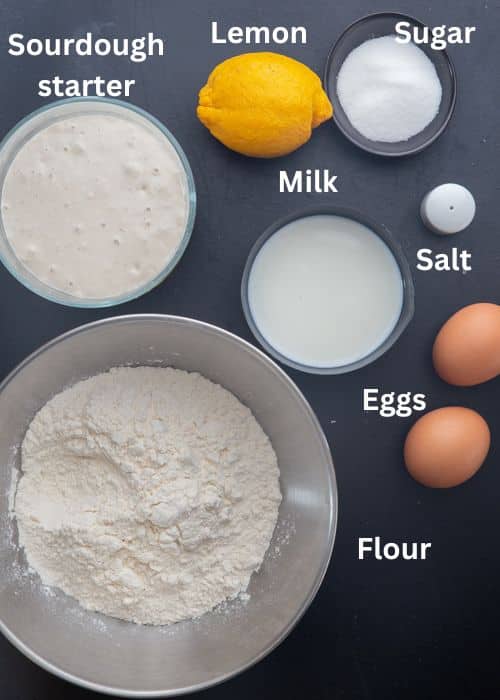
What temperature is lukewarm?
Lukewarm is considered between 105-110F (40-43C). Be aware that the yeast will die at a temperature over 140F (60C).
Variations
- Glaze: Add a simple powdered sugar glaze or powdered sugar lemon glaze after the bread has cooled.
- Orange Zest: Swap the lemon zest for orange zest for a different citrus variation
- Filling: You could make a sweet streusel filling or a savory filling like in Italian casatiello napoletano.
- Dried fruit: Candied dried fruit or raisins could be added similar to a colomba Easter bread.
- Easter eggs: Tuck uncooked eggs into the shaped wreath. If you use hard boiled eggs they will become too warm and crack.
How to Make Sourdough Easter Bread
In the bowl of a standing mixer fitted with flat beaters, add milk and sugar then stir to combine. Add the sourdough starter and then mix together with the flat beaters.
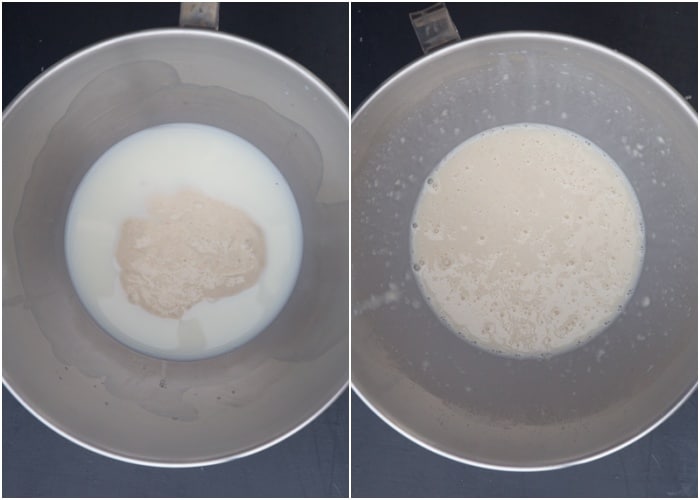
Add the flour, egg, yolk, vanilla and zest, then using a dough hook knead just until the dough starts to come together. Cover the bowl and let it rest for 20 minutes.

After 20 minutes, start to knead the dough. While kneading continuously, add the softened butter then the salt. Knead for 15-20 minutes, until the dough is soft and elastic.
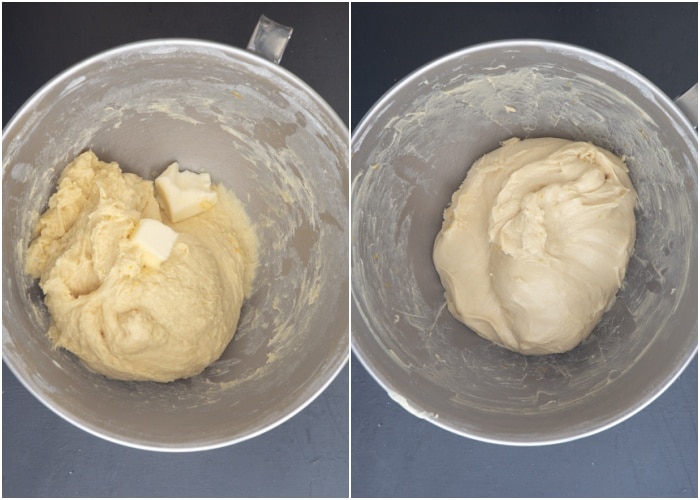
Move the dough to a flat surface and form into a ball.
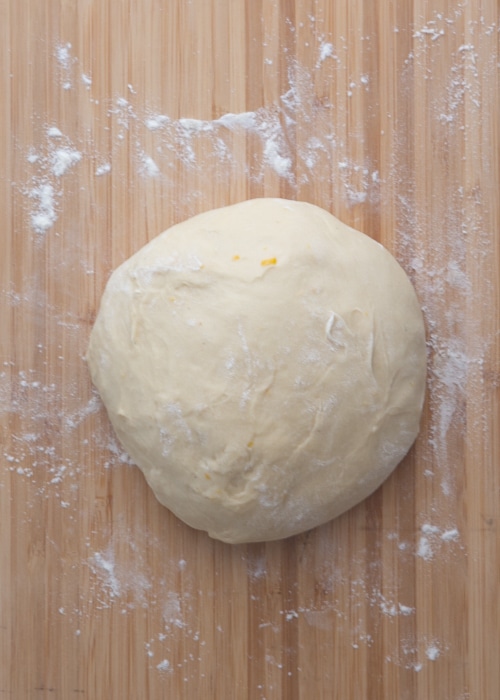
Place the dough in a bowl, cover it and then let rise in a warm area that is draft free for 2 hours. After 2 hours, place the bowl in the fridge overnight for 8-10 hours.
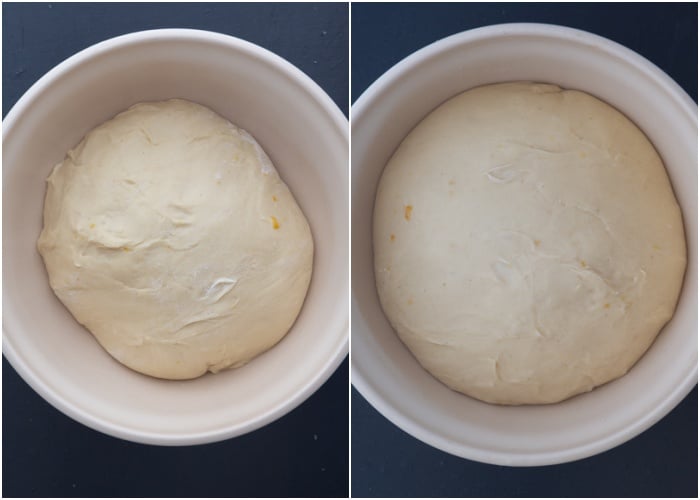
Remove the dough from the fridge and place dough on a lightly floured surface and shape or braid into desired shape.
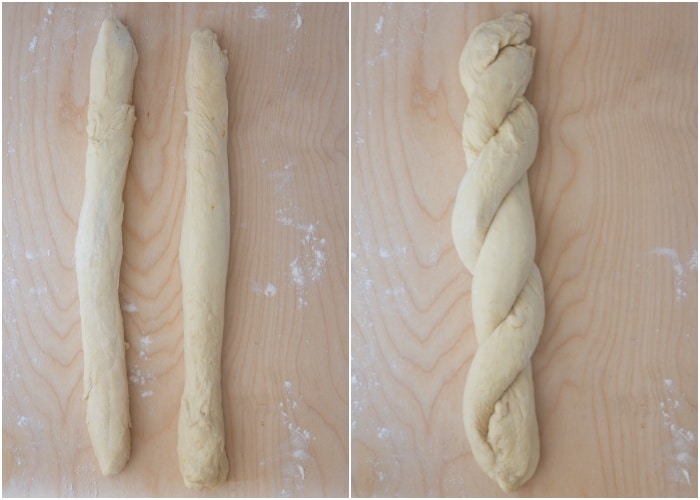
Transfer dough to a parchment paper lined baking sheet then cover and let rise for 6-8 hours or until doubled in bulk.
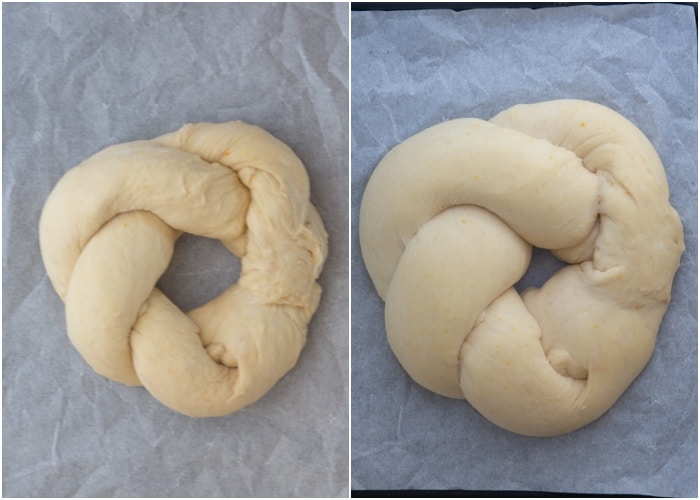
After your dough has doubled, brush with an egg wash or milk. Or you can lightly brush it with water and sprinkle with nonpareils. Check to make sure they don’t bleed. If you prefer you can also add uncooked colored eggs to the bread. Bake the bread until golden brown. Cool for 10 minutes before serving.
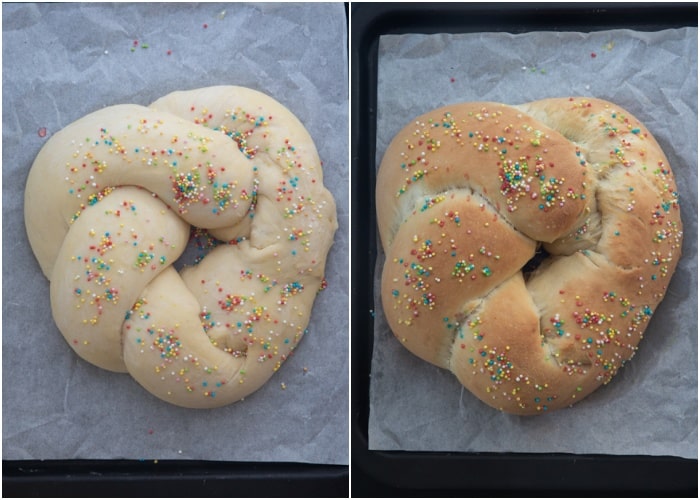
A Timeline for This Holiday Bread
Since this sourdough Easter bread is enriched with butter, eggs and milk the fermentation process may be longer than you are used to with other sourdough bread recipes. If you plan to enjoy this sourdough at your Easter dinner celebration, this timeline will be helpful for planning purposes. Adjust accordingly for when you plan to enjoy your bread.
- Saturday afternoon before Easter: Prepare the starter, cover and leave at room temperature for 2 hours.
- Saturday night before Easter: Place the covered dough in the refrigerator overnight for at least 8 – 10 hours.
- Early Easter morning: Remove dough from the refrigerator and shape into desired shape. Leave at room temp to proof for at least 6 – 8 hours.
- Easter midday: Preheat the oven, brush dough with egg wash and bake the bread for your Easter dinner.
Shaping Your Bread
While you can shape the sourdough into a loaf and bake it, making it into a braided wreath is not only a pretty presentation but traditional. To shape it into a wreath follow these easy steps!
- Divide the dough into two or three pieces.
- Roll each piece of dough into a long rope. Each rope should be roughly 30 inches long and equally thick along the entire length.
- Gather the ends of all ropes together then braid by crossing two of the ropes then put the third rope in between the previously crossed ropes. Pick up the rope that is farther spaced from the others and braid it between the two more tightly crossed ropes. Continue this braiding pattern until the whole bread is braided. If you use two ropes (like it did) just twist the ropes one over the other.
- Last, connect the end pieces to form the braided wreath.
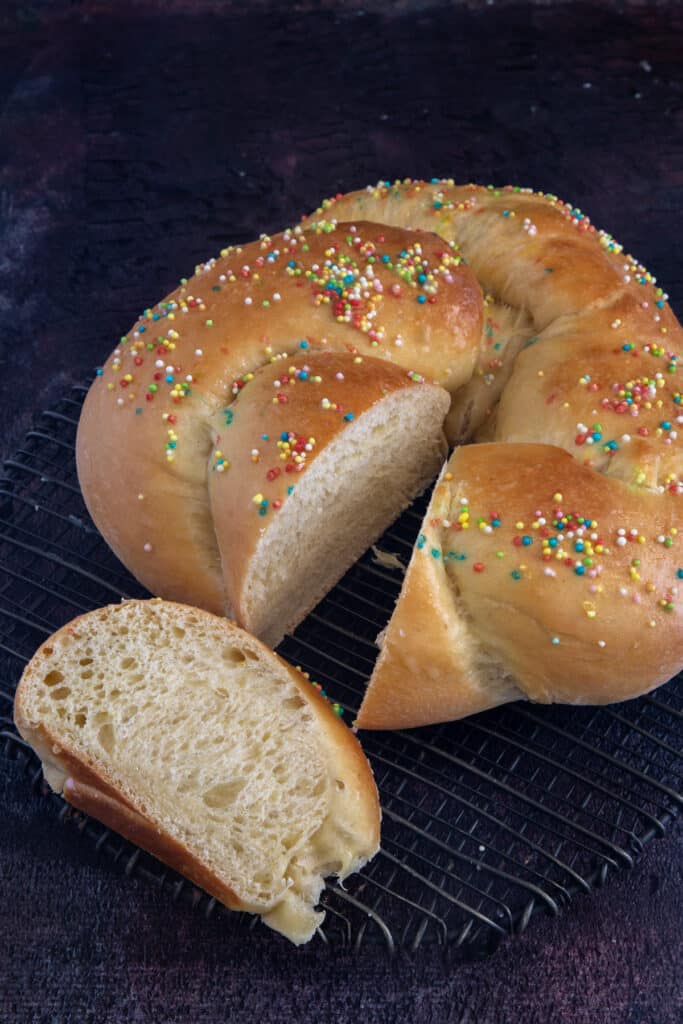
Baking Tips
- If you use eggs in your braid they need to be uncooked eggs.
- If you plan to use nonpareils use an egg wash, milk or water but check because they could bleed.
- You will need an active sourdough starter, so you may need to feed your starter a couple of times, it should be very active meaning it will double in 3-4 hours after a feeding. I fed mine the night before and again in the morning. You will need ½ cup active starter.
- If you have shaped your Easter sourdough bread into a wreath, during the proofing process place a cup in the center to prevent dough from expanding and closing off the wreath center. Remove the cup before baking.
- The internal temperature of the bread should be 190F/188C when tested with an internal thermometer.
FAQs
You will need 3-4 hours for starter preparation, or longer if your starter has been in the fridge for awhile, 8-10 hours for the bulk fermentation and 6 – 8 hours for proofing. For planning purposes, your Sourdough Easter bread will need roughly 18 hours of rise time.
Following the directions for activating your starter, bulk fermentation and proofing your bread will result in a great sourdough bread!
Although not as traditional as the braided wreath, in other areas of Europe Easter bread is baked in paper molds similar to panettone or even recycled tins that give each loaf of bread a unique shape.
How to store the Sourdough Easter Bread
Store the completely cooled bread in an airtight container or zip-top bag. You can keep it at room temperature for 2-3 days or in the fridge for up to 5-6 days. Bring to room temperature or warm in the oven before serving.
How to freeze the bread
The completely cooled bread can be frozen either sliced or whole. Wrap the bread tightly with foil or plastic wrap, then place in a freezer bag or container. It will keep for up to three months if properly stored.
So if you are looking for something different to make with your sourdough starter, I hope you give this Easter Bread a try and let me know how it goes. Enjoy and Happy Easter!

More Delicious Easter Treats
- Homemade Easter Eggs
- Italian Easter Cookies
- Hot cross scones
- Easter egg tiramisu
- Ricotta Easter Bread

Sourdough Easter Bread
Equipment
- stand mixer
- 1 baking sheet
Ingredients
- ½ cup milk lukewarm
- ¼ cup granulated sugar
- ½ cup sourdough starter
- 2½ cups + 2 tablespoons all purpose flour (325 grams total)
- 1 large egg (room temperature)
- 1 large egg yolk (room temperature)
- 1 teaspoon vanilla
- ½-1 tablespoon lemon zest
- ⅓ cup butter softened
- ¾ teaspoon salt
Instructions
- In the mixer add the milk and sugar, stir to combine, then add the sourdough starter and mix together with the flat beaters.
- Add the flour, egg, yolk, vanilla and zest, with the dough hook knead just until it start to come together it will look shaggy. Cover the bowl and let rest 20 minutes.
- Start to knead, then add the butter a little kneading continuously, add the salt and knead for 15-20 minutes, until soft and elastic.
- Place the dough in a bowl and cover, let rise in a warm draft free area for 2 hours, then place in the fridge over night (8-10 hours).
- Remove from the fridge and place the dough on a lightly floured flat surface, shape or braid into desired shape. Place on a parchment paper lined baking sheet. Cover and let rise 6-8 hours, until doubled in bulk.
- Pre-heat oven to 350F/180C.
- Brush the dough with an egg wash or milk. Bake for 25-35 minutes. Test with a toothpick or a thermometer, temperature should be 190F/88C when done.
- I find if I use nonpareils then lightly press into the dough without using an egg wash or milk as they will bleed.
After tweaking this recipe to make it traditional in flavor for my Italian husband.
And by using my type of sugars rather than traditional sugar, because my husband is also diabetic. Plus the sourdough keeps it gluten-free, which we both are gluten intolerant. 🤪
I left out the lemon flavors and added Anise flavor and seed to keep my husband happy and in tradition.
Topping it off with evaporated milk and Anise seed to keep from adding sugar and dyes from the candies.
This sourdough Easter bread, turned out much better than expected with the most pleasing texture we have ever had. Loved it.⭐️⭐️⭐️⭐️⭐️
Hi Wendy, thanks so much, so glad you both enjoyed it and thank you for sharing the additions and changes you made. Take care!